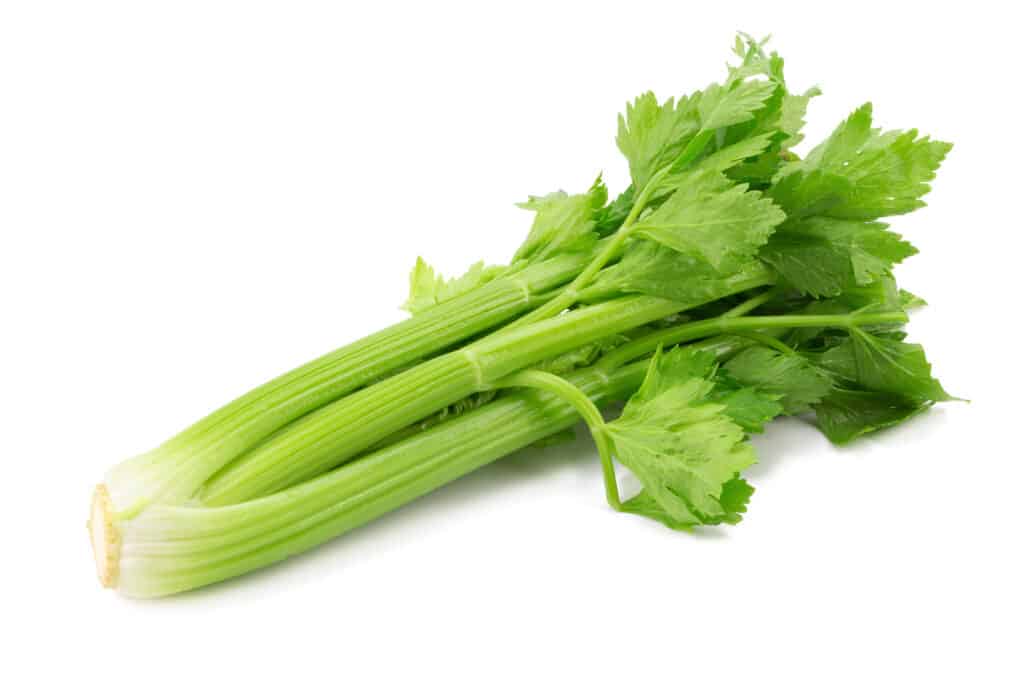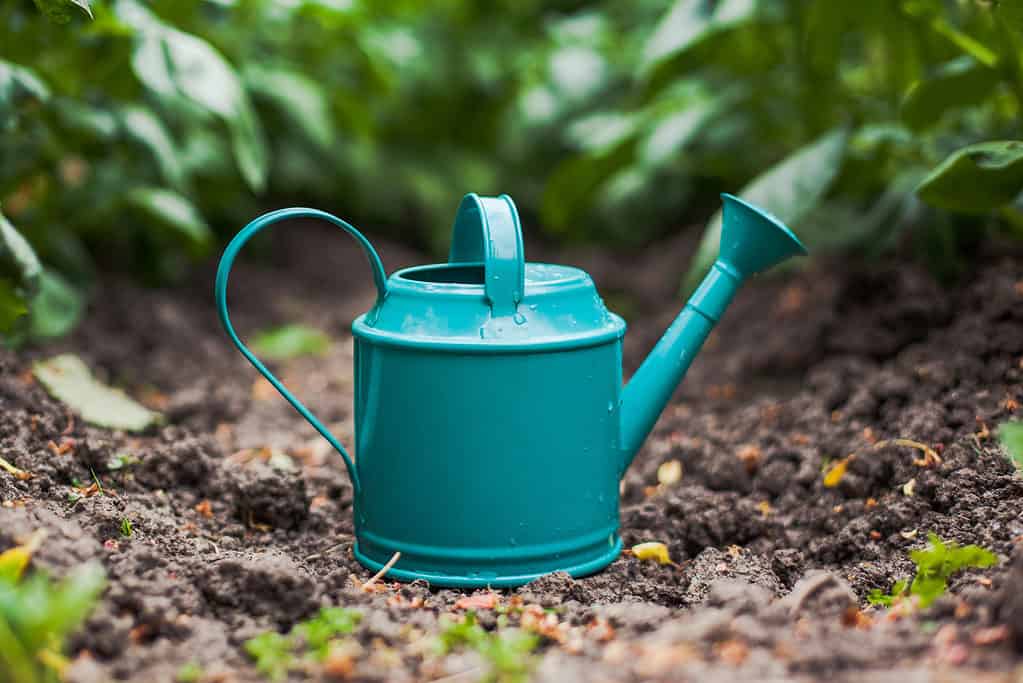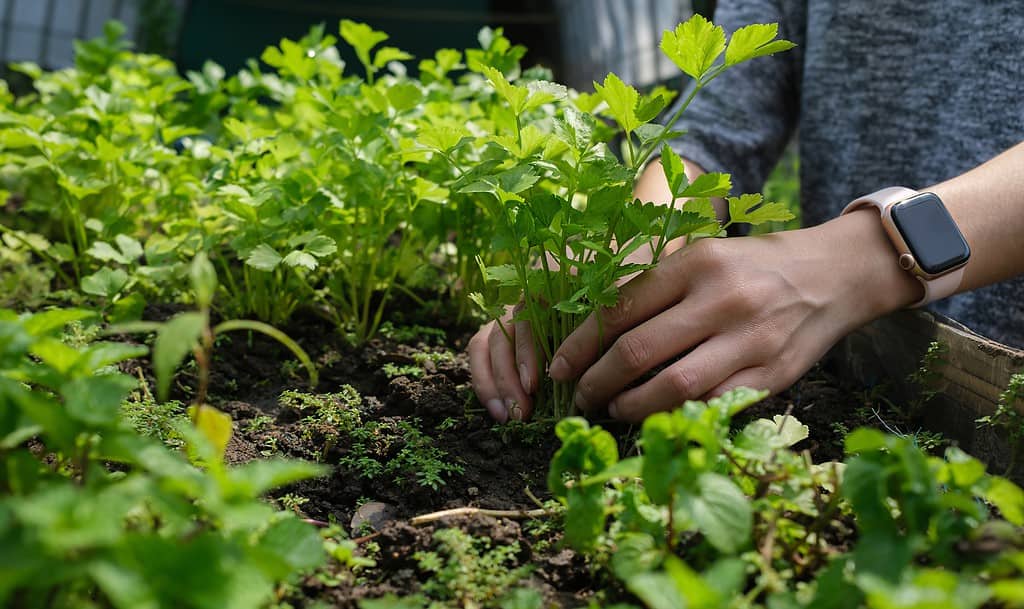Popular for use in salads, soups, and a variety of other dishes, celery is an excellent crop to grow as an antioxidant-rich food source. If you want to know how to grow celery, you’ve come to the right place!
In this guide, we’ll cover the botanical classification of celery, its native range, characteristics, how to grow this vegetable from seed, and how to transplant it.
Let’s jump in!
Celery: Botanical Classification, Native Range, and Characteristics

You can grow several varieties of celery.
©Kaiskynet Studio/Shutterstock.com
An herbaceous plant that belongs to the parsley, or Apiaceae family, domesticated celery is a cultivated descendent of its ancestor, wild celery (Apium graveolens). The domesticated form of celery in which the plant is grown for consumption of the stalk (also known as stalk celery) is classified as Apium graveolens var. dulce. This is the most widely grown form of celery and what you typically see in North American grocery stores. The other two forms major varieties descendant from wild celery are Apium graveolens var. rapaceum (grown for root consumption), and Apium graveolens var. secalinum (grown for leafy foliage consumption)
Native to the temperate and Mediterranean lowland, marshy regions of Asia, Northern Africa, and Europe, Apium graveolens likely became cultivated for use as stalk celery by Italian farmers in the 17th century. Through years of domestication, farmers selectively bred celery for non-hollow stalks that became thicker and sweeter than those of its wild ancestor. European settlers then introduced this domesticated, cultivated variety of celery, Apium graveolens var. dulce, into North America.
Today, stalk celery grows as a biennial or perennial herb, generally reaching about 30 inches tall. It is popularly grown in many gardens, where it can self-seed and escape cultivation. Escape celery is invasive in some areas, such as in the Southwest US.
How to Grow Celery

Following the recommended watering requirements is a good consideration for how to grow on celery well.
©iStock.com/Tgordievskaya
To grow a successful celery crop, you’ll need to know what growing zones are suitable for this plant, its ideal soil and sunlight conditions, watering and fertilizing requirements, and how to direct sow it from seed and via transplanting. Below, we’ll cover each of these care requirements and growing methods.
USDA Hardiness Zones for Celery
Depending on the variety, you can grow celery in USDA growing zones 2-10. Most gardeners choose cold-hardy stalk celery cultivars such as ‘Pascal’ to grow in these colder regions. Regardless of variety, you’ll need to wait until temperatures exceed 40 degrees Fahrenheit before planting outside.
Ideal Soil Conditions
Celery is a bit of a finicky plant that needs loose, well-draining, fertile, moist, and somewhat acidic soil (5.8-6.8) to thrive. Ideally, soil structure should be loose, fluffy, and well-aerated to a depth of 12-15 inches. Celery roots aren’t particularly hardy and have difficulty pushing through compacted and rocky soil, so providing ideal soil conditions is crucial to growing a healthy crop. You can use a garden fork or tiller to loosen your soil and inject oxygen, but it’s important to understand that deep tilling leads to compaction in the long term. So, if you decide to till to loosen your soil, you’ll need to do this every season to continually address compaction.
If you have sandy soil, you’ll want to amend it with materials to improve moisture retention, such as compost and sphagnum peat moss. Celery needs a lot of water and does not do well in soil that is too fast-draining. It can tolerate soggy soils much better than soil that doesn’t retain moisture. You can also add a layer of mulch on top of the soil to aid in moisture retention.
How to Grow Celery: Ideal Sunlight Conditions
Planting in an area with at least 6 hours of full sun exposure is crucial for a productive, thriving celery crop. Ideally, you’ll want to plant celery in an area that receives morning-to-noon full sun but partial shade in the afternoon, as too intense of direct sunlight can burn this sensitive plant.
Watering Requirements
As we mentioned above, celery is quite a heavy drinker, so you’ll need to stay on top of a consistent watering schedule. By weight, celery is about 95% water and naturally grows in marshy areas. If it doesn’t receive enough water during its growing phase, you’ll find the celery stalks will be dry and lacking in moisture. Aim for about 2 inches of water per week during its growing season through either drip irrigation or hand-watering multiple times per week. During their dormant phase, they still need about .5-1 inch of water per week to maintain good health.
How to Grow Celery: Fertilizer Requirements
Celery is a moderate feeder and, in particular, requires high amounts of potassium to become well-established. Recommended fertilizer mixes include 4-4-8 and 5-10-10 NPK (Nitrogen-Phosphorus-Potassium). Once your young celery plants are well-established, you can also add high-nitrogen mixes, such as 21-0-0 NPK, to encourage abundant above-ground growth.
If transplanting, you can add a high-potassium liquid fertilizer at the time of planting and a high-nitrogen mix at 4 and 8 weeks after transplanting. Just be careful not to apply fertilizer directly to the plant, especially when young, as this can burn its delicate foliage and roots. Instead, apply fertilizer about 4 inches away from the plant. You can add about 1/4 cup of liquid fertilizer for every 10-foot row of celery plants. If growing from seed, wait until your plants are about 4 weeks old to fertilize.
Direct Sowing Celery Seeds into Your Garden

Celery stalks can grow up to 10 inches.
©Ton Photographer 4289/Shutterstock.com
Ideally, you’ll want to wait until temperatures reach about 75 degrees Fahrenheit during the day, and about 60 degrees at night, before direct sowing celery seeds into your garden. At this temperature, seeds should germinate in about 10 days. You can plant them into the soil at lower temperatures, down to 40 degrees Fahrenheit, but germination time will be much longer, at 30-40 days.
When directly sowing celery seeds, you must expose them to water to trigger germination. Remember, the ancestor of domesticated celery typically grows in marshy areas, so they naturally need the presence of water to trigger germination. Before planting, soak your seeds in room-temperature water for 24 hours to speed up germination.
Celery seeds are quite tiny, so you’ll only want to plant them about 1/8″ deep and about 6″ apart into soft, fluffy soil. Space rows about 24 inches apart. When covering the seed holes, you’ll want to use a finely sifted potting mix to gently cover the seeds unless your soil is quite aerated and not prone to compaction. This ensures that very delicate seedlings can push through the soil.
Once your seedlings have reached about 6 inches tall, you can thin them to 8-12 inches apart. If you choose to grow from seed, be prepared to sit back and wait, as these plants are slow-growers and can take up to 140 days before being ready for their first harvest. You can first harvest when the lower stalks of the plant are 6 inches tall.
How to Grow Celery From Transplants
If you live in an area with a cold spring or don’t want to wait several months for your plants to grow from seed, you can always purchase young celery plants to transplant into your garden. For most people growing in temperate regions, starting seeds indoors 10 weeks before the last frost or purchasing young celery plants are better options than direct sowing.
Once temperatures consistently reach about 70 degrees Fahrenheit during the day, you can transplant your celery into your garden. The seedlings should have 3-4 mature leaves at this point. Choose a day that is somewhat overcast and not windy to reduce the chances of your plants developing transplant shock. Space the celery plants about 12″ apart with rows spaced apart by 24″. If you space them further apart, the stalks will not grow as densely or upward since they’ll have more room to spread outward.
The photo featured at the top of this post is © Ton Photographer 4289/Shutterstock.com
Thank you for reading! Have some feedback for us? Contact the AZ Animals editorial team.







